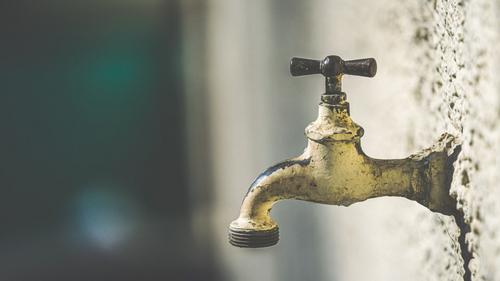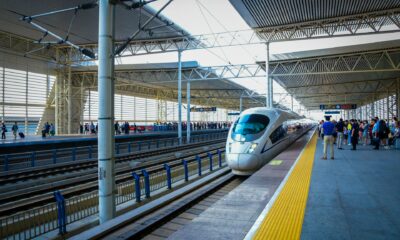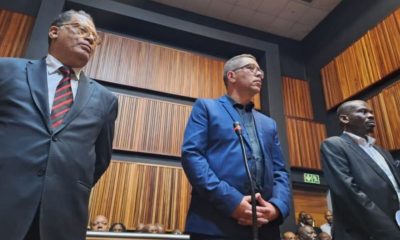News
City Issues Apology for Massive Water Shortages and Chaos

The Mayor of Johannesburg, Thapelo Amad, and the MMC for Environment and Infrastructure Service Department, Jack Sekwaila, held a press briefing on water service interruptions in Johannesburg on 26 March. Ntshavheni Mukwevho, the managing director of Johannesburg Water, was also present, according to Southern Courier.
On 20 March, a pump failure at the Eikenhof pump station resulted in critically low water levels in several reservoirs across the city. This event has affected the Commando System, which supplies water to the Brixton, Crosby, and Hursthill reservoirs, and, consequently, the pumping capacity to the Forest Hill and Crown Garden reservoirs.
Sekwaila stated that Amad had asked him to reassure residents that the City of Johannesburg takes this matter seriously and regards it as a priority to ensure uninterrupted water supply to residents across the city. He also requested Mukwevho’s presence to give residents hope that Johannesburg Water would restore the water supply.
Also read: Outrage as Johannesburg Residents Left Without Water for Two Weeks
In the past ten weeks, Johannesburg Water’s system has been under immense pressure due to Rand Water experiencing various failures on its bulk infrastructure. In addition, the City of Johannesburg is supplied from the Eikenhof, Zwartkopjes, and Palmiet booster stations, which have been affected by frequent power failures, vandalism to infrastructure, and planned infrastructure maintenance work. These factors have contributed to low or empty water supply in various areas across the city.
According to him, Eikenhof supplies parts of South Johannesburg, West Johannesburg, Randburg, Roodepoort, and Soweto and has been affected by frequent power failures. Zwartkopjes provides the central and northern areas of Johannesburg and has been affected by both vandalism and power failures. Finally, Palmiet supplies parts of South Johannesburg, East Johannesburg, Sandton, Midrand, and Diepsloot and has also been affected by frequent power failures and vandalism.
He expressed concern and sympathy for the mounting frustrations of residents. He apologised for the disruption to their daily lives and the inconvenience it had caused. Providing good-quality water and sanitation services that are accessible to all remains their top priority for the residents of Johannesburg.
Also read: Gauteng Water Shortage Solutions Uncertain – What’s Next?
Johannesburg Water is working hard to restore the water systems and stabilise the system. They will continue to provide residents with mobile water tankers and stationary tanks located in strategic areas, prioritising medical facilities, schools, and nursing homes before residential areas.
We have deployed 28 mobile water tankers and 12 stationary tankers to areas affected by the Eikenhof system pump failure, such as Robertsham, Booysens, Crosby, Melville, and Crown Garden Clinic.
“We are working closely with the ward councillors in all affected areas to assist us in identifying a central area where we can deploy our stationary and mobile tankers,” he said.
Johannesburg Water is restoring the reservoir and towers, and pumping into the towers resumed on 25 March, with the reservoir at 50% capacity. Robertsham, Ormonde, and the surrounding areas were the most affected.
Johannesburg Water’s dedicated team will regularly inspect and clamp down on illegal connections to deal with theft and the loss of assets.
“While we continue to deal with these challenges and ensure taps do not run dry, let us ensure that we conserve water in our communities and report irresponsible use of water and illegal connections. Johannesburg Water will implement medium-term measures (over the next two years) within the Commando Supply System to ensure the sustainability of the water supply – a R402m investment,” he said.
Also read: Joburg Water attributes water crisis to frequent power outages
Johannesburg Water will also invest in the following programmes:
Reservoir storage upgrades.
Water pipe replacement in various regions.
Water conservation (WC) and water demand management (WDM) will include repairs of the leaking reservoirs and tower infrastructure. The WC/WDM strategy aims to reduce demand by 37,123Ml per annum from the technical interventions. In addition, WC initiatives will contribute to further demand reduction.
Bulk pipe renewal/upgrades.
Johannesburg Water continues to have a big task of supplying 1.6 billion litres of potable water daily, procured from Rand Water through a water distribution network of 12,369km, 128 reservoirs and water towers, and 37 water pump stations.
“We want our operations to normalise and to fulfil this mandate. We are here to serve you, the residents of Johannesburg,” noted Sekwaila.
Also read:
Picture: Photo by Patrick Pahlke on Unsplash






















